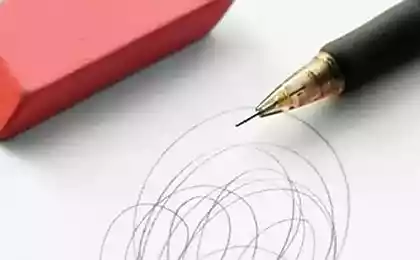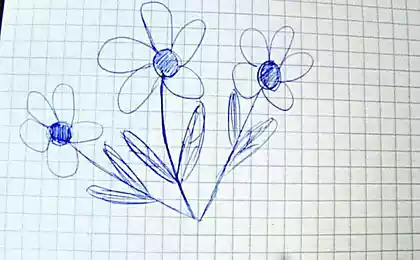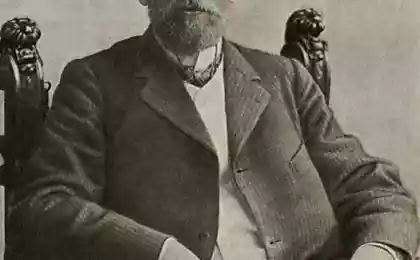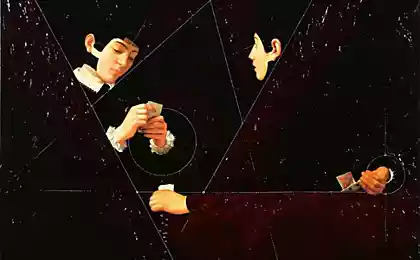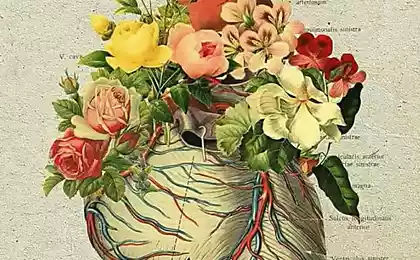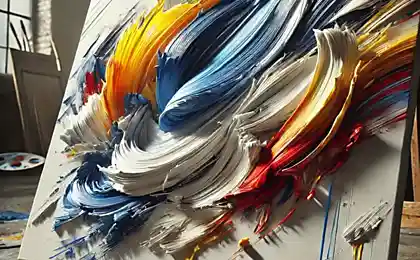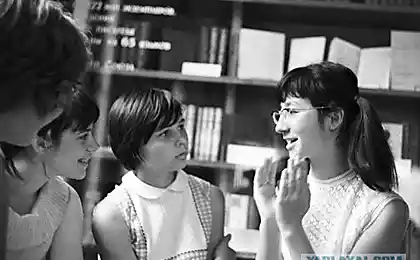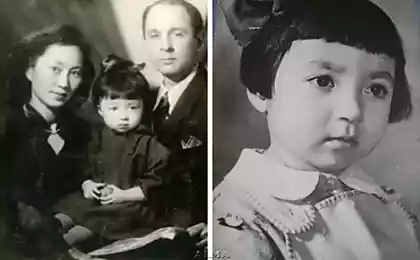213
What do we mean by drawings that we do not think about drawing on paper?

The author of this drawing is a creative and talented nature. This is a bright, sensual person, with a strong erotic view of the world (this is evidenced by the hypertrophied size and shape of the noses and eyes, rounded eyelashes, juicy lines). The juiciness and emotional generosity of the character, as well as the creative activity of the author, are emphasized by large rounded forms in combination with the saturation of the image. “We need to look forward, not backward,” says the reversal of the picture: its right part (future time) prevails over the left (past).
Human figures
Pay attention to the details. If they are little men, then most likely you feel helpless or want to evade any duties. When you depict a person schematically ("stick, stick, cucumber - that's what the man came out") - your emotional state is unstable, you want to close and not let anyone near you.
1. Head in profile, and body face – you live anxiety caused by the social environment and the need for communication, full face – you are open to communication, the more a person “turns away”, “leaves” – the more you seek to avoid external contacts.
2. A big head - guided primarily by thought, a small one - pay little importance to intellectual work, poorly drawn - show shyness and timidity. If you carefully draw your face, then you are very concerned about your appearance and relationships with other people, it is important for you how you are “met by clothes”.
3. Closed, hidden or undrawn eyes indicate a desire to avoid unpleasant visual stimuli, unwillingness to really see unpleasant moments of life.
4. Large ears – you are sensitive to criticism and dependent on the opinions of others, too small or absent – do not want to listen to others’ views and positions.
5. Large shoulders or body – you have a feeling of great strength or excessive preoccupation with power, small – a sense of insignificance and insignificance, sloping shoulders or a stooped body – despondency, despair, guilt and lack of vital energy.
6. Hands are a symbol of interpersonal relationships. If your hands are far from your body (sided) – your actions are out of control when crossed on your chest – you are hostile, behind your back or in your pockets – unwillingness to give in, compromise, pinned to your body – you have difficulties in social contact.
7. Long legs indicate the need for independence, short legs - you will experience a feeling of physical or psychological awkwardness. The legs are widely spaced - outright neglect and ignoring the interlocutors and their actions, the legs together (a person stands "on the string") - stiffness in communication.

“To do something worthwhile, you need to cut off everything superfluous” – the simplicity of the form indicates that the author is more interesting to get to the bottom of things than to engage in conversations around the bush. Flushing around the letters increases the concentration of a person on the problem, and also speaks of the ability to refrain from hasty conclusions. A sense of humor helps not to take life too seriously (light round elements "h" and "f", a lot of space surrounding the word).
The behavior of the author does not depend on the opinion of others. He is “a cat that walks by itself” – a light press combined with the central location of the text on the page suggests that, preferring to be in the center of events, he is not very eager to bind himself to the duties of a leader, but can be a good adviser, having a theoretical mindset. Being sincere, this person does not like pretense and tinsel, is prone to specifics and is confident in his own rightness (large vertical letters of simple shape).
Personal signatures: such machine drawings are characteristic of a vanity and egocentric nature. An abundance of your own murals, automatically displayed on a sheet during a conversation, or thinking about a problem, signals that you are too fixated on your own person. It's time to look around.
Squares, triangles and other geometric shapes: you have clear goals and beliefs, you almost never hide your opinion, always persistent and persistent. You are usually overly vigilant and cautious, so try to look at things more easily.
Circles and rings: circles connected to each other or inscribed in each other indicate a desire to join and participate. “I feel lonely, I feel like I’m disconnected from the outside world,” the drawings signal. By drawing circles on paper, the unconscious hints that you lack friendly participation and attention.

The big picture in the center of the page says, “The center of the world is me, everything else is my companions.” Smooth and rounded elements of the drawing say: "I am good-natured and love you all!" And the view from the back means, "But I got tired of you, and I went!" The author is characterized by thoroughness and slowness. The creativity of the artist is obvious: in the few elements, all possible messages are transmitted.
Animals: Your current emotions may depend on the animal that settled on your paper. If it’s a tiger or a wolf, aggression is hidden in you, if a fox is conceived to cheat somewhere, a bunny or a squirrel – you need care and protection, a lion – you feel your superiority over everyone. This mechanism is similar to the allegorical significance of animals and their characters in fairy tales, parables and children's stories. When you constantly portray the same beast, bird or bug, you are most likely comparing him to yourself, ascribe to yourself his habits.
Spirals, circles, or wavy lines mean that other people’s problems don’t bother you too much, or at all. You may even be experiencing a mild emotional crisis: walking around your ambiguous experiences. Now you need to monitor your behavior so as not to flare up and break out on others.
Arrow: This is the vector by which you navigate your life. The arrow is directed upwards - orientation to other people, downwards - to yourself, to the left - look into the past, to the right - hope for the future.

The drawing is saturated with erotic motifs - the theme of love pleasure at the moment is not the last in the list of things that bother the author. Soft, floating, elegant forms speak of the artist’s concern for luxury, as well as her ability to avoid a direct answer. At the same time, she pays close attention to small details - both in the drawing, in conversation and in life.
The author seeks to protect himself from problems - this is seen by the numerous crosses, grids, as well as the flower umbrella. Light pressure indicates intelligence, and in combination with loops, spirals and the overall saturation of the page - a good creative potential. In this case, the spirals indicate that a person is able to change the direction of thinking and consider different options.
Stars: You want to be the center of attention, it is important for you to be bright and always noticed. But if your star has too many rays, or if you depict them separately from it, it may indicate depressive experiences.
Flowers, sun, clouds: cheerful flowers and sunshine are sure signs that you are happy with how the phone conversation goes. Most likely, listening to the interlocutor, you along the way already dream, fantasize about something pleasant. Such drawings with your head betray your optimistic mood and benevolent mood.
Crosses: You may be bothered by feelings of guilt in front of a loved one or some problem that you feel responsible for.
Houses and boxes: Symmetrical shapes show a love of order, a propensity for planning and calculation. This is what the picture says: “I am not easily confused, I know exactly what I want, I have clear goals and I am going to strongly defend my opinion.”
Chess Fields: Apparently, you have found yourself in a very unpleasant or at least difficult position. If such images appear often, then you most likely suffer from hidden complexes associated with the inability to resolve a situation or are in search of yourself, your life path, doubt the correctness of your life.
Bee honeycombs: You seek peace, harmony, and order your life. You may be thinking about creating a family nest.
Now try to analyze the doodles you draw while sitting in a boring lecture, meeting, or talking on the phone. By the way, graphology – the science of the connection of handwriting with the character of a person – is still not recognized as official psychology. Scientists successfully prove both that the conclusions that graphologists make are true and the opposite. At the same time, the services of graphologists are enviable popular, especially abroad. published
P.S. And remember, just by changing your consciousness – together we change the world!
Source: /users/78

